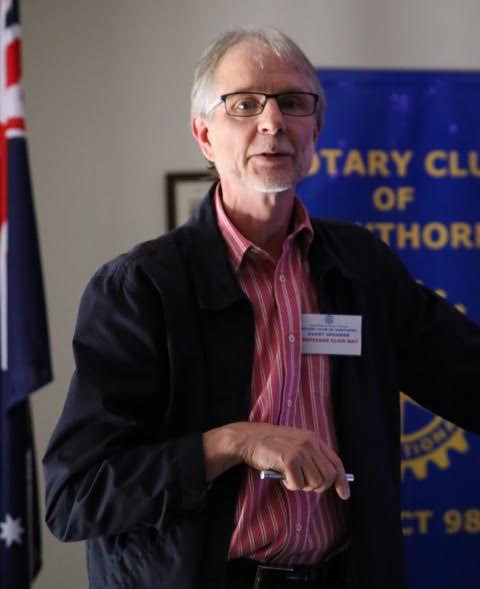Proessor Clive May ...Neuro-cardiovascular Research
Posted
on May 10, 2016

Appropriately our own medical club member Tilak Dissanayake introduced and chaired the address/discussion presented by Professor Clive May.
Clive is a research professor at the Florey Institute of Neuroscience and Mental Health at the University of Melbourne and Head of the Neuro-cardiovascular laboratory. Originally from the UK with a BSc and PhD from Southampton University, and a mix of medical research experience in industry and St Mary’s Hospital Medical School, London, about 20 years ago he joined the Howard Florey Institute. Clive commented that he was attracted by that institutes reputation for being one of the world leaders in medical research (and he noted it still is) and opportunity to participate.
Nowadays his major research interest is how the brain and nervous system interacts with the cardiovascular system.
We got a quick lesson and example in how the brain controls heart rhythms, and where a damaged heart (after a heart attack say) can be over stimulated in response to the brains role to sustain blood flow to other organs and be further damaged. Intervention at the brain level, be it by electrical means or creating impeding lesions on key nerves can reduce this over stimulation.
It opened the way to two other topics invoking research linking instrumentation to the body. Clive joked that many thought of him as a hybrid medico/electronic engineer.
Cleverly keeping the address at a high level to not lose the audience we learnt of research into establishing bio-markers (looking at oxygen levels in the kidneys) to identify the early onset of septic shock (a major issue after surgery …at present 30% mortality) and then the use of electrodes in the brain by which paralyzed individuals may control external aids. A new advance here involved “stentrodes” a means of inserting electrodes into the blood vessels of the brain thus overcoming the brains usual response to ultimately scar and block an electrode.
After answering the usual personal medical queries from the audience, Clive discussed how such research needs huge funding to go beyond the conceptual stage and so often by necessity leads to overseas relationships (mostly the USA) and the devolution of Australian property rights. The audience was left pondering on the Australian attitude to research, and how its research dollars are allocated.